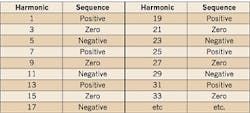Ask the Experts
Anyone will tell you, if you're going to have any success in dealing with power quality problems — particularly with issues of a harmonic nature — you're going to have to know your definitions. This month, John DeDad, EC&M's editorial director, takes a look at positive, negative, and zero sequence harmonics and explains how they affect different equipment.
Q. In some harmonic mitigation product literature, I've seen the terms “positive sequence,” “negative sequence,” and “zero sequence” used to refer to specific harmonic currents. What do these terms mean and why are they important?
DeDad's answer: Positive sequence harmonic currents are the 1st, 7th, 13th, 19th, etc. harmonics. They consist of three phasors, each equal in magnitude but separated from each other by a 120° phase displacement. These harmonic currents have the same phase sequence as phasors that represent normal 60-Hz current.
Negative sequence harmonic currents are the 5th, 11th, 17th, etc. harmonics. Like positive sequence harmonic currents, they consist of three phasors, each equal in magnitude but separated from each other by a 120° phase displacement. However, these phasors have a phase sequence opposite to phasors that represent normal 60-Hz current.
Zero sequence harmonic currents are the 3rd, 9th, 15th, etc. harmonics. They consist of phasors equal in magnitude but with zero displacement from each other. Because these phasors are concurrent in direction, they produce an amplitude three times greater than any one phasor when they combine on the neutral of an electrical system. You'll also see these harmonics referred to as triplen harmonics. PCs, older versions of electronic ballasts, and phase-to-neutral nonlinear loads typically generate these harmonic currents (Table 1 at left).
Specific harmonics are associated with various types of equipment. For example, phase-to-phase nonlinear loads, such as equipment with six-pulse rectifiers, generate high levels of 5th and 7th harmonics, with lower levels of the 11th and 13th harmonics. Equipment with 12-pulse rectifiers generate the same harmonic currents but substantially lower levels of the 5th and 7th (Table 2 here).
Got a PQ problem? E-mail your question to [email protected]
